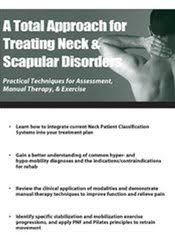Sue DuPont – A Total Approach for Treating Neck & Scapular Disorders
$200.00 Original price was: $200.00.$75.05Current price is: $75.05.
Whether the cause is from a traumatic injury, or from the chronic effects of age, posture, and wear-and-tear, many of these patients suffer with significant pain and disability.
Sue DuPont – A Total Approach for Treating Neck & Scapular Disorders
Injuries in the neck and shoulder region affect over 1/3 of the adult population, and they can be very disabling and costly to the patient. X-ray findings often do not correlate with symptoms, yet these patients continue to have pain. Also, impairments in the scapula-thoracic and lumbar regions have been shown to affect the alignment and biomechanics of the cervical spine.
Whether the cause is from a traumatic injury, or from the chronic effects of age, posture, and wear-and-tear, many of these patients suffer with significant pain and disability. Muscle imbalances and altered length-tension relationships of soft tissues make it increasingly more difficult to effectively treat these patients. Passive treatment approaches simply are not effective.
This recording will explore the latest techniques for assessing and treating neck and shoulder girdle pain and dysfunction. Current treatment-based classification systems for neck patients will be presented, as well as today’s best-practices for objectively determining the underlying causes of dysfunction and applying effective treatment strategies.
- Review current classification systems for neck patients
- Differentiate diagnoses for hyper- and hypo-mobility conditions in cervical-scapula-thoracic regions
- Gain a better understanding of common surgical and non-surgical interventions and indications/contraindications for rehabilitation
- Review the clinical application of modalities and demonstrate manual therapy techniques to improve function and relieve pain
- Identify specific stabilization and mobilization exercise progressions for improved outcomes
- Apply PNF and Pilates principles to retain movement
Introduction
- Why we need to understand the neck and shoulder girdle better
- Review of current biomechanical theories and research on cervical spine
- Using Classification Systems and Functional Index findings to guide treatment planning
- Causes of neck pain and disability—biomechanical and neurological changes
Common Hyper- and Hypo-Mobility Diagnoses Therapists Treat in the Cervical and Scapular-Thoracic Region
- Whiplash, Herniated Nucleus Pulposus (HNP), spondylosis, radiculopathy, scoliosis
- Hypo-mobility diagnoses—stenosis, kyphosis, facet joint dysfunction, Degenerative Disk Disease (DDD)
How Do We Stabilize?
- Review of relevant functional anatomy of the cervical-scapulo-thoracic region
- Discuss biomechanical model of the Cervical Motion Segment and effects of instability
- Effects of posture and aging on tissue structure and motor control
Lab 1: Palpation AND Posture Assessment
- Bony structures and gross muscle testing
- Posture observations and documentation of scoliosis and scapular winging
- Special tests—Jull’s Test for Cranio-cervical stability, Standing Arm Elevation, Axial compression, vertebral artery, Spurling’s test, and Scapular Balancing Index
Common Surgical and Non-Surgical Treatments
- Laminectomy, discectomy, cervical fusion, disc replacement
- Pain management strategies—spinal injections, trigger point injections, Botox, and acupuncture
- Clinical Modalities—iontophoresis, manual vs. mechanical traction
Would you like to receive Sue DuPont – A Total Approach for Treating Neck & Scapular Disorders ?
Lab 2: Hands-On Treatment Techniques
- Mobility testing and TMJ screening
- Soft Tissue Mobilization—passive release, muscle energy release, and tissue unwinding
- Demonstration of advanced mobilization techniques—MET and Mobilization with movement
Neuromuscular Re-Education: Clinical Applications AND Treatments
- Pressure biofeedback for deep neck flexors and scapular stability exercises
- Specialized taping techniques using kinesio-taping and McConnell taping strategies
Stabilization for Neck AND Scapula
- Critical links and 3 Postural Zones
- Weak links in the Stability Chain
- Progression of Exercise Programs
Lab 3: Stabilization AND Scapular Mobility Exercises
- Deep neck flexor training and Cervical “clock” exercises
- Connecting the postural zones
- Mobilization exercises for Scapular-thoracic region
- Building scapula-thoracic postural control
- Advanced exercise techniques—gliding discs, yoga, PNF, and dynamic reaction training
Be the first to review “Sue DuPont – A Total Approach for Treating Neck & Scapular Disorders” Cancel reply
Related products
NLP - Self-help - Dating
NLP - Self-help - Dating
NLP - Self-help - Dating
Dr. Bradley Nelson – The Body Code System 2.0 (Complete) + BONUS
NLP - Self-help - Dating
NLP - Self-help - Dating
Dr William Horton – NLP Basic Practitioner Certification Course
NLP - Self-help - Dating
Complete HypnoThoughts Live 2016 Conference (Audio Recordings Package)
NLP - Self-help - Dating
Gerald Kein – 33 Courses Collection | Ultra-Height Hypnosis, Omni Hypnosis, …
NLP - Self-help - Dating













Reviews
There are no reviews yet.